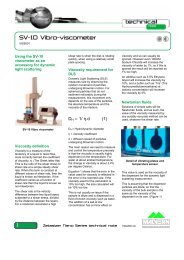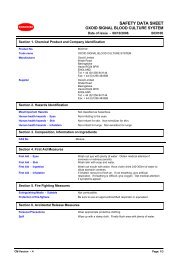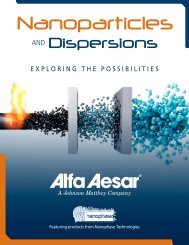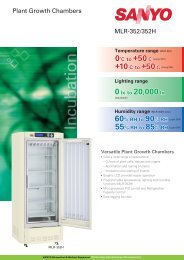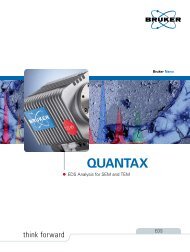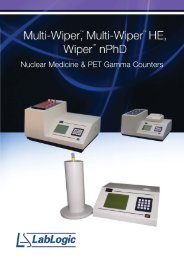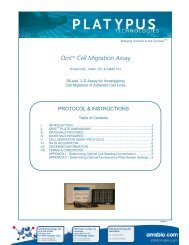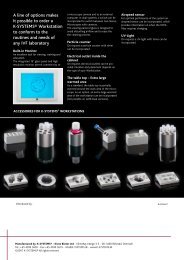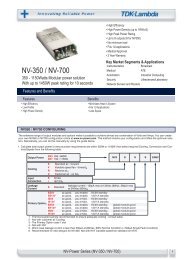Boronic Acids - Labface
Boronic Acids - Labface
Boronic Acids - Labface
You also want an ePaper? Increase the reach of your titles
YUMPU automatically turns print PDFs into web optimized ePapers that Google loves.
<strong>Boronic</strong> <strong>Acids</strong><strong>Boronic</strong> acids and their derivatives are among the most useful classes of organoboronmolecules. Unlike many organometallic derivatives and most organoboranes, boronicacids are usually stable to air and moisture, and are of relatively low toxicity andenvironmental impact. The reactions of boronic acids can be divided into two categoriesaccording to whether the boron-oxygen or the carbon-boron bonds are involved.Reactions involving the B-O bondsBoroxine formationMost boronic acids readily undergo dehydration to form cyclic trimeric anhydrides(boroxines) (Scheme 1). This tends to occur spontaneously at room temperature, so that itis difficult to obtain the acid free from the anhydride. Since in almost all cases, both willundergo the required reaction, they can usually be regarded as equivalent.Scheme 1Boronate formationThe ease with which boronic acids react with diols, with loss of water, to give cyclicboronic esters (boronates) has led to their application in a number of areas, especially inthe carbohydrate field.Protection of diolsOne of the main applications of boronic acids has been as reagents for protection andderivatization of 1,2- and 1,3-diols as boronates (1,3,2-dioxaborolanes and 1,3,2-dioxaborinanes),particularly in carbohydrate chemistry. 1 These have been widely used asvolatile derivatives for GC and GC-MS purposes. The boronate derivatives are formedsimply by stirring the boronic acid and diol together at ambient temperature, by warming,or, if necessary, with azeotropic removal of water. Usually cleavage occurs readily underhydrolytic conditions, by exchange with a glycol, 2 or by treatment with hydrogen peroxide. 3Hindered boronic esters, such as those of pinacol, may be relatively stable to hydrolysis,and can often be purified by chromatography. A useful application of boronate protectionis in the osmium tetroxide catalysed cis-dihydroxylation of alkenes under anhydrousconditions in the presence of a boronic acid. 3b,4 Further information on the applications ofboronic acids as derivatizing and protecting agents can be found in various reviews 5,6 andmonographs. 7-9NORTH AMERICATel: 1-800-343-0660 or1-978-521-6300Fax: 1-800-322-4757Email: info@alfa.comGERMANYTel: 00800 4566 4566 or+49-721-84007-280Fax: 00800 4577 4577 or+49-721-84007-300Email: Eurosales@alfa.comUNITED KINGDOMTel: 0800-801812 or+44 (0) 1524-850506Fax: +44 (0) 1 524-850608Email: UKsales@alfa.comFRANCETel: 0800 03 51 47 or+33 03 88 62 26 90Fax: 0800 10 20 67Email: frventes@alfa.comwww.alfa.comINDIATel:+91 (0)44 2815 4153 orFax: +91 (0)44 2815 4154Email: India@alfa.comCHINATel: +86 (010) 8567-8600Fax: +86 (010) 8567-8601Email: saleschina@alfa-asia.comKOREATel: 82-2-3410-6000Fax: 82-2-3140-6001Email: saleskorea@alfa-asia.com
<strong>Boronic</strong> <strong>Acids</strong>Other applications in carbohydrate chemistryThe formation of boronates with carbohydrate molecules has been utilized in numerousother applications, including the selective transport of sugars in lipophilic environments,10,11 and the design of artificial receptors, as discussed in several reviews. 12-15<strong>Boronic</strong> acids and esters in asymmetric synthesisChiral boronatesMatteson has carried out extensive work on cyclic boronates, 16,17 formed from chiral diolssuch as (1S,2S,3R,5S)-2,3-pinanediol or (R,R)-(-)-2,3-butanediol, which undergo carboninsertion with LiCHCl 2 in the presence of zinc chloride in up to 99% diastereomeric excess(de). Treatment of the resulting α-chloro boronic esters with various nucleophiles leads toα-substituted boronic esters which can be deprotected with hydrogen peroxide, or thesequence can be repeated to introduce a second chiral center, as illustrated in Scheme 2.Scheme 2OxazaborolidinesReaction of various boronic acids with chiral amino alcohols gives oxazaborolidines, whichwere introduced by Corey as excellent catalysts for enantioselective borane reduction ofketones with very high ee. 18 The reagents derived from α,α-diphenylprolinol have receivedthe most attention, although the use of other amino alcohols has also been reported. 19,20For further details, reaction scheme and references, see under (S)-(-)-α,α-Diphenylprolinol,(S)-2-Methyl-CBS-oxazaborolidine monohydrate and n-Butylboronic acid in themain Catalogue. Reviews on the use of oxazaborolidines as enantioselectivecatalysts, 21,22 and the asymmetric reduction of ketones 23,24 are available.NORTH AMERICATel: 1-800-343-0660 or1-978-521-6300Fax: 1-800-322-4757Email: info@alfa.comGERMANYTel: 00800 4566 4566 or+49-721-84007-280Fax: 00800 4577 4577 or+49-721-84007-300Email: Eurosales@alfa.comUNITED KINGDOMTel: 0800-801812 or+44 (0) 1524-850506Fax: +44 (0) 1 524-850608Email: UKsales@alfa.comFRANCETel: 0800 03 51 47 or+33 03 88 62 26 90Fax: 0800 10 20 67Email: frventes@alfa.comwww.alfa.comINDIATel:+91 (0)44 2815 4153 orFax: +91 (0)44 2815 4154Email: India@alfa.comCHINATel: +86 (010) 8567-8600Fax: +86 (010) 8567-8601Email: saleschina@alfa-asia.comKOREATel: 82-2-3410-6000Fax: 82-2-3140-6001Email: saleskorea@alfa-asia.com
<strong>Boronic</strong> <strong>Acids</strong>Diels-Alder reactions<strong>Boronic</strong> acids form stable chiral acyloxyborane (CAB) catalysts with tartaric acidderivatives, which have been developed by Yamamoto as catalysts for asymmetric Diels-Alder 25 and hetero Diels-Alder 26 reactions, for example between aldehydes andDanishefsky’s Diene [1-methoxy-3- (trimethylsiloxy)-1,3-butadiene; L06100, L14672], togive enantioselectively, dihydro-4-pyrone derivatives. 27For the use of a boronic acid template in stereocontrolled Diels-Alder reactions, 28 seeunder Benzeneboronic acid in the main section of the Catalogue.Reactions involving cleavage of the C-B bondIn these reactions, displacement of boron by an electrophilic species takes place withformation of a new carbon-carbon or carbon-heteroatom bond.C-C bond forming reactions: Suzuki biaryl couplingThe discovery by Suzuki and Miyaura 29 that arylboronic acids undergo palladiumcatalyzedcross-coupling with aryl halides in the presence of a base (Scheme 3) hasstimulated enormous interest in the application of this (the Suzuki reaction), and variantsdeveloped subsequently, to the synthesis of unsymmetrical biaryls and relatedcompounds.Scheme 3Many of the methods previously employed for such syntheses involve the direct couplingof highly-reactive organometallic reagents (Grignard, organolithium, etc.) with aryl halidesin the presence of various catalysts. Such reactions are of limited utility, since thepresence of many functional groups interferes. <strong>Boronic</strong> acids, on the other hand, whichare air-stable materials of relatively low toxicity, will undergo the Suzuki reaction in thepresence of a wide variety of functional groups. The highly versatile Stille couplingreaction, 30 by comparison, 31 involves toxic organotin species. Under the standard couplingconditions, aryl bromides are most frequently used as the electrophilic species, butiodides are more reactive. The successful coupling of the more readily available, butnormally unreactive aryl chlorides has been achieved under modified conditions, usingeither palladium 32 or nickel 33 catalysts. A catalytic cycle for the Suzuki reaction 34,35 isoutlined in Scheme 4. A detailed mechanistic study has also been published. 36NORTH AMERICATel: 1-800-343-0660 or1-978-521-6300Fax: 1-800-322-4757Email: info@alfa.comGERMANYTel: 00800 4566 4566 or+49-721-84007-280Fax: 00800 4577 4577 or+49-721-84007-300Email: Eurosales@alfa.comUNITED KINGDOMTel: 0800-801812 or+44 (0) 1524-850506Fax: +44 (0) 1 524-850608Email: UKsales@alfa.comFRANCETel: 0800 03 51 47 or+33 03 88 62 26 90Fax: 0800 10 20 67Email: frventes@alfa.comwww.alfa.comINDIATel:+91 (0)44 2815 4153 orFax: +91 (0)44 2815 4154Email: India@alfa.comCHINATel: +86 (010) 8567-8600Fax: +86 (010) 8567-8601Email: saleschina@alfa-asia.comKOREATel: 82-2-3410-6000Fax: 82-2-3140-6001Email: saleskorea@alfa-asia.com
<strong>Boronic</strong> <strong>Acids</strong>Scheme 4Alternative illustrative experimental procedures for the biaryl synthesis have been reportedin Organic Syntheses. 37 Useful reviews of the Suzuki and related reactions have beenpublished by Suzuki and Miyaura 38,39 and by Martin and Yang, 35 and of biaryl synthesisvia cross-coupling reactions by Stanforth. 40 The more recent literature has been reviewedby Kotha et al. 88Related coupling reactionsA variety of heterocyclic halides have been coupled with boronic acids, including thiophenes,41 furans, thiazoles, 42 isoxazoles, 43 pyridines, 44,45 pyrimidines 42,44 andpyrazines. 44,45 Aryl or vinyl triflates can undergo palladium-catalyzed boronic acidcoupling, which usefully extends the scope of the reaction to phenols or enols. 46-48Coupling of boronate derivatives with aryl mesylates, catalyzed by nickel complexes, hasalso been reported, 49,50 as has palladiumcatalyzed coupling with sulfonium salts. 51Arenediazonium tetrafluoroborates have been found to undergo coupling with arylboronicacids in dioxane or methanol, catalyzed by palladium acetate in the absence of bothadded base and phosphine ligand. 52 This has been extended to the coupling of arenediazoniumtetrafluoroborates with potassium aryltrifluoroborates, 53 which are morenucleophilic than the corresponding arylboronic acids, and also with potassium vinyltrifluoroborates, 54 which are air-stable crystalline solids, more readily prepared andisolated than the corresponding vinylboronate esters. Alkenyl and aryl trifluoroborateshave also been reported by Molander to couple with aryl halides, which greatly extendstheir usefulness. 89Coupling of arylboronic acids with, for example vinylic halides, 55,56 or allenyl methylcarbonate, 57 have also been described.NORTH AMERICATel: 1-800-343-0660 or1-978-521-6300Fax: 1-800-322-4757Email: info@alfa.comGERMANYTel: 00800 4566 4566 or+49-721-84007-280Fax: 00800 4577 4577 or+49-721-84007-300Email: Eurosales@alfa.comUNITED KINGDOMTel: 0800-801812 or+44 (0) 1524-850506Fax: +44 (0) 1 524-850608Email: UKsales@alfa.comFRANCETel: 0800 03 51 47 or+33 03 88 62 26 90Fax: 0800 10 20 67Email: frventes@alfa.comwww.alfa.comINDIATel:+91 (0)44 2815 4153 orFax: +91 (0)44 2815 4154Email: India@alfa.comCHINATel: +86 (010) 8567-8600Fax: +86 (010) 8567-8601Email: saleschina@alfa-asia.comKOREATel: 82-2-3410-6000Fax: 82-2-3140-6001Email: saleskorea@alfa-asia.com
<strong>Boronic</strong> <strong>Acids</strong>Coupling reactions invoving alkylboronic acids were reported to be difficult to accomplish.90 However, Molander has described conditions under which primary alkylboronicacids could be coupled efficiently with aryl halides and triflates. 91A further useful variation of the Suzuki reaction, shown in Scheme 5, is the carbonylativecross-coupling of arylboronic acids with aryl iodides in the presence of carbon monoxideat atmospheric pressure, to give substituted benzophenones. 58Scheme 5Unsymmetrical ketones have also subsequently been prepared by cross-coupling ofarylboronic acids with acyl chlorides, catalyzed either by (Ph 3 P) 4 Pd, 59 or Pd(OAc) 2 with noadded ligand. 60Tetrakis(triphenylphosphine)palladium(0) was the catalyst originally employed for thebiaryl coupling, 29 and is still the most popular. A wide variety of alternative catalysts havebeen reported for Suzuki and related couplings, including: (Ph 3 P) 2 PdCl 2 , 43,58dppbPdCl 2 , 44,61 “Pd(dba) 2 ”, 62 Pd(OAc) 2 , 52,63 Pd(OAc) 2 /(o-tol) 3 P, 45,64 Pd(OAc) 2 /dppf, 45(PhCN) 2 PdCl 2 /Ph 3 As, 56 (CH 3 CN) 2 PdCl 2 , 58 Pd-C, 65 (Ph 3 P) 2 NiCl 2 , 50 and the palladacyclecomplex trans-di-µ-acetatobis[2-(di-o-tolylphosphino)-benzyl]dipalladium(II). 66Alternative bases to sodium carbonate include: NaHCO 3 , 43,67 K 2 CO 3 , 54 Cs 2 CO 3 , 32bK 3 PO 4 , 49 Et 3 N, 45,64a Ag 2 O, 56 Ba(OH) 2 , 68 good for sterically-hindered biaryls, and CsF, 69compatible with readily-hydrolyzed functionality, such as esters. Suzuki and Miyaura 29reported that stronger bases such as ethoxide or hydroxide gave poorer yields thancarbonate; sodium acetate was also found to be ineffective.The palladium-catalyzed coupling of boron compounds with aryl halides has beenextended by Miyaura’s group to the cleavage of a boron-boron bond in the one-stepconversion of aryl halides to boronic esters using the novel reagent Bis(pinacolato)diboron (L16088), 70 allowing access to boronic acid derivatives without protection offunctionalities such as ester, ketone, cyano or nitro groups. For reaction scheme andfurther uses of this reagent, see text entry in main section of the Catalogue.NORTH AMERICATel: 1-800-343-0660 or1-978-521-6300Fax: 1-800-322-4757Email: info@alfa.comGERMANYTel: 00800 4566 4566 or+49-721-84007-280Fax: 00800 4577 4577 or+49-721-84007-300Email: Eurosales@alfa.comUNITED KINGDOMTel: 0800-801812 or+44 (0) 1524-850506Fax: +44 (0) 1 524-850608Email: UKsales@alfa.comFRANCETel: 0800 03 51 47 or+33 03 88 62 26 90Fax: 0800 10 20 67Email: frventes@alfa.comwww.alfa.comINDIATel:+91 (0)44 2815 4153 orFax: +91 (0)44 2815 4154Email: India@alfa.comCHINATel: +86 (010) 8567-8600Fax: +86 (010) 8567-8601Email: saleschina@alfa-asia.comKOREATel: 82-2-3410-6000Fax: 82-2-3140-6001Email: saleskorea@alfa-asia.com
<strong>Boronic</strong> <strong>Acids</strong>1,2- and 1,4-additions to carbonyl compoundsMiyaura has also described the conjugate addition of arylboronic acids to enones, in thepresence of a rhodium catalyst and a chelating phosphine, to give good yields ofsaturated ketones. 71 Under similar conditions, both aryl- and alkenylboronic acids can addto aldehydes to give secondary alcohols in high yield (Scheme 6). 72Scheme 6An extension of these reactions to the addition of potassium alkenyl- andaryltrifluoroborates to aldehydes and enones has also been reported. 73C-O, C-N and C-S bond-forming reactionsOne of the simplest reactions of arylboronic acids is their oxidative cleavage, usually withhydrogen peroxide, 74 to give phenols. Other oxidative reactions with NBS or NIS to givearyl halides are known. 75 More usefully, arylboronic acids undergo Ullmann-type C-O andC-N coupling reactions with phenols, 76,77 amines, amides and imides, 77,78 ureas,sulfonamides and carbamates, 75 and N-heteroaromatics 79 in the presence of copper(II)acetate (Scheme 7) to give the corresponding diaryl ethers, arylamines or N-arylheterocycles.Scheme 7Formation of unsymmetrical thioethers from arylboronic acids and thiols, mediated bycopper(II) acetate has also been reported. 80NORTH AMERICATel: 1-800-343-0660 or1-978-521-6300Fax: 1-800-322-4757Email: info@alfa.comGERMANYTel: 00800 4566 4566 or+49-721-84007-280Fax: 00800 4577 4577 or+49-721-84007-300Email: Eurosales@alfa.comUNITED KINGDOMTel: 0800-801812 or+44 (0) 1524-850506Fax: +44 (0) 1 524-850608Email: UKsales@alfa.comFRANCETel: 0800 03 51 47 or+33 03 88 62 26 90Fax: 0800 10 20 67Email: frventes@alfa.comwww.alfa.comINDIATel:+91 (0)44 2815 4153 orFax: +91 (0)44 2815 4154Email: India@alfa.comCHINATel: +86 (010) 8567-8600Fax: +86 (010) 8567-8601Email: saleschina@alfa-asia.comKOREATel: 82-2-3410-6000Fax: 82-2-3140-6001Email: saleskorea@alfa-asia.com
<strong>Boronic</strong> <strong>Acids</strong>Other reactions of boronic acidsMany other examples of boronic acid chemistry have been reported:For ortho-specific α-hydroxyalkylation of phenols by aldehydes, 81 see under Benzeneboronicacid in the main section of the Catalogue.With lead(IV) acetate, catalysed by mercury(II) acetate, arylboronic acids are transmetalatedto the aryllead triacetate, used in situ for electrophilic arylation, for example ofactive methylene compounds, 82 or with sodium azide in DMSO for the preparation of arylazides, providing a useful two-step route for the preparation of these from aryl halides. 83Arylboronic acids have been converted, via the N-methyldiethanolamine cyclic esters, toaryl fluorides using cesium fluoroxysulfate. 84<strong>Boronic</strong> acids undergo a Mannich-type reaction with aldehydes and secondary amines. 85For asymmetric boronic acid Mannich reaction with aldehydes, 86 see under Furan-2-boronic acid.Certain arylboronic acids have also been shown to be effective catalysts for amidation ofcarboxylic acids. 87Product ListingsAlkenylboronic acids and estersL19700 3-Acetoxy-1-propenylboronic acid pinacolesterL19579 3-Diethoxy-1-propenylboronic acid pinacolesterL19649 (E)-1-Heptene-1,2-diboronic acidbis(pinacol ester)L19650 (E)-1-Hexene-1,2-diboronic acidbis(pinacol ester)L19704 4-Methyl-β -styrylboronic aciddiethanolamine esterL19698 4-Methyl-β-styrylboronic acid pinacol esterL19697 1-Octenylboronic acid pinacol esterL19705 4-Octenylboronic acid diethanolamine esterL19699 4-Octenylboronic acid pinacol esterL19677 1-Pentenylboronic acidL19648 (E)-1-Pentene-1,2-diboronic acidbis(pinacol) esterL19701 5-Phenyl-1-pentenylboronic acid pinacolesterL19652 (E)-Stilbenediboronic acid bis(pinacol ester)L19573 cis-Stilbeneboronic acid diethanolamineesterL19576 cis-Stilbeneboronic acid pinacol esterL19651 (E)-α,β-Styrenediboronic acidbis(pinacol ester)L19571 β-Styrylboronic acid diethanolamine esterL19529 β-Styrylboronic acid pinacol esterL19577 2-(Trimethylsilyl)vinylboronic acidpinacol esterL19811 Vinylboronic acid pinacol esterNORTH AMERICATel: 1-800-343-0660 or1-978-521-6300Fax: 1-800-322-4757Email: info@alfa.comGERMANYTel: 00800 4566 4566 or+49-721-84007-280Fax: 00800 4577 4577 or+49-721-84007-300Email: Eurosales@alfa.comUNITED KINGDOMTel: 0800-801812 or+44 (0) 1524-850506Fax: +44 (0) 1 524-850608Email: UKsales@alfa.comFRANCETel: 0800 03 51 47 or+33 03 88 62 26 90Fax: 0800 10 20 67Email: frventes@alfa.comwww.alfa.comINDIATel:+91 (0)44 2815 4153 orFax: +91 (0)44 2815 4154Email: India@alfa.comCHINATel: +86 (010) 8567-8600Fax: +86 (010) 8567-8601Email: saleschina@alfa-asia.comKOREATel: 82-2-3410-6000Fax: 82-2-3140-6001Email: saleskorea@alfa-asia.com
<strong>Boronic</strong> <strong>Acids</strong>Alkylboronic acids and estersL16232 Allylboronic acid pinacol esterA13725 n-Butylboronic acidL19575 2-(9H-Carbazolyl)ethylboronic aciddiethanolamine esterL19580 2-(9H-Carbazolyl)ethylboronic acid pinacolesterL19957 n-Decylboronic acidL19532 3,3-Diethoxy-1-propylboronic acid pinacolesterL19533 2-(1,3-Dioxolan-2-on-4-yl)-1-ethylboronicacid pinacol esterL19703 2,2-Diphenyl-1-ethylboronic aciddiethanolamine esterL19958 n-Dodecylboronic acidL19959 Ethylboronic acidB22446 n-Hexylboronic acidAlkylboronic acids and estersL16232 Allylboronic acid pinacol esterA13725 n-Butylboronic acidL19575 2-(9H-Carbazolyl)ethylboronic aciddiethanolamine esterL19580 2-(9H-Carbazolyl)ethylboronic acid pinacolesterL19957 n-Decylboronic acidL19532 3,3-Diethoxy-1-propylboronic acid pinacolesterL19533 2-(1,3-Dioxolan-2-on-4-yl)-1-ethylboronicacid pinacol esterL19703 2,2-Diphenyl-1-ethylboronic aciddiethanolamine esterL19958 n-Dodecylboronic acidL19959 Ethylboronic acidB22446 n-Hexylboronic acidAlkenyltrifluoroborate saltsL17973 Potassium 4-methyl-β-styryltrifluoroborateL17971 Potassium β-styryltrifluoroborateL19574 2-Indanylboronic acid diethanolamine esterL19535 2-Indanylboronic acid pinacol esterL19962 Isopropylboronic acidL15589 Methylboronic acidL19964 n-Octylboronic acidL19871 2-Phenylethyl-1-boronic acidL19706 2-Phenylethyl-1-boronic aciddiethanolamine esterL19530 2-Phenylethyl-1-boronic acid pinacol esterL19965 n-Propylboronic acidL19966 n-Tetradecylboronic acidL19572 2-Trimethylsilyl-1-ethylboronic aciddiethanolamine esterL19534 2-Trimethylsilyl-1-ethylboronic acid pinacolesterL19574 2-Indanylboronic acid diethanolamine esterL19535 2-Indanylboronic acid pinacol esterL19962 Isopropylboronic acidL15589 Methylboronic acidL19964 n-Octylboronic acidL19871 2-Phenylethyl-1-boronic acidL19706 2-Phenylethyl-1-boronic aciddiethanolamine esterL19530 2-Phenylethyl-1-boronic acid pinacol esterL19965 n-Propylboronic acidL19966 n-Tetradecylboronic acidL19572 2-Trimethylsilyl-1-ethylboronic aciddiethanolamine esterL19534 2-Trimethylsilyl-1-ethylboronic acid pinacolesterL17970 Potassium vinyltrifluoroborateNORTH AMERICATel: 1-800-343-0660 or1-978-521-6300Fax: 1-800-322-4757Email: info@alfa.comGERMANYTel: 00800 4566 4566 or+49-721-84007-280Fax: 00800 4577 4577 or+49-721-84007-300Email: Eurosales@alfa.comUNITED KINGDOMTel: 0800-801812 or+44 (0) 1524-850506Fax: +44 (0) 1 524-850608Email: UKsales@alfa.comFRANCETel: 0800 03 51 47 or+33 03 88 62 26 90Fax: 0800 10 20 67Email: frventes@alfa.comwww.alfa.comINDIATel:+91 (0)44 2815 4153 orFax: +91 (0)44 2815 4154Email: India@alfa.comCHINATel: +86 (010) 8567-8600Fax: +86 (010) 8567-8601Email: saleschina@alfa-asia.comKOREATel: 82-2-3410-6000Fax: 82-2-3140-6001Email: saleskorea@alfa-asia.com
<strong>Boronic</strong> <strong>Acids</strong>Arylboronic acids con’tL15634 2-Fluorobiphenyl-4-boronic acidL17851 3-Fluoro-4-formylbenzeneboronic acidL17808 4-Fluoro-3-formylbenzeneboronic acidL19655 2-Fluoro-3-methoxybenzeneboronic acidL19960 2-Fluoro-4-methoxybenzeneboronic acidL19818 3-Fluoro-4-methoxybenzeneboronic acidB24512 3-Fluoro-4-methylbenzeneboronic acidB24117 4-Fluoro-2-methylbenzeneboronic acidL18753 4-Fluoro-3-methylbenzeneboronic acidL19819 5-Fluoro-2-methylbenzeneboronic acidB25434 2-Formylbenzeneboronic acidB25437 3-Formylbenzeneboronic acidB25199 4-Formylbenzeneboronic acidL17850 3-Formyl-4-methoxybenzeneboronic acidL19059 5-Formyl-2-methoxybenzeneboronic acidL19400 2-Hydroxybenzeneboronic acidL19061 3-Hydroxybenzeneboronic acidL15594 4-Hydroxybenzeneboronic acidL15192 2-(Hydroxymethyl)benzeneboronicacid hemiesterL15193 3-(Hydroxymethyl)benzeneboronic acidL15194 4-(Hydroxymethyl)benzeneboronic acidL20110 2-Isopropylbenzeneboronic acidL15530 3-Isopropylbenzeneboronic acidL17459 4-Isopropylbenzeneboronic acidL17460 5-Isopropyl-2-methoxybenzeneboronic acidL17865 4-(Methanesulfinyl)benzeneboronic acidL17720 4-(Methanesulfonyl)benzeneboronic acidB21071 2-Methoxybenzeneboronic acidB24412 3-Methoxybenzeneboronic acidA14462 4-Methoxybenzeneboronic acidL17958 2-(Methoxycarbonyl)benzeneboronic acidL19820 4-Methoxy-3,5-dimethylbenzeneboronicacidL20112 4-Methoxy-2-methylbenzeneboronic acidL19821 4-Methoxy-3-methylbenzeneboronic acidL19060 6-Methoxy-2-naphaleneboronic acidB23154 2-Methylbenzeneboronic acidB23025 3-Methylbenzeneboronic acidA13347 4-Methylbenzeneboronic acidB24217 3,4-(Methylenedioxy)benzeneboronic acidL17456 2-(Methylthio)benzeneboronic acidL20250 3-(Methylthio)benzeneboronic acidB23454 4-(Methylthio)benzeneboronic acidB21219 1-Naphthaleneboronic acidB24157 2-Naphthaleneboronic acidL17988 2-Nitrobenzeneboronic acidA13336 3-Nitrobenzeneboronic acidL17004 trans-4-(β-Nitrovinyl)benzeneboronic acidL17753 4-n-Nonylbenzeneboronic acidB22922 2,3,4,5,6-Pentafluorobenzeneboronic acidL18011 4-n-Pentylbenzeneboronic acidL19824 2,3,4,5-Tetrafluorobenzeneboronic acidL19825 2,3,4,6-Tetrafluorobenzeneboronic acidL19826 2,3,5,6-Tetrafluorobenzeneboronic acidL19827 2,3,4-Trifluorobenzeneboronic acidL17511 2,3,5-Trichlorobenzeneboronic acidL19402 2,4,6-Trifluorobenzeneboronic acidL18519 3,4,5-Trifluorobenzeneboronic acidL19774 2-(Trifluoromethoxy)benzeneboronic acidL19775 3-(Trifluoromethoxy)benzeneboronic acidB23233 4-(Trifluoromethoxy)benzeneboronic acidB24343 2-(Trifluoromethyl)benzeneboronic acidB21661 3-(Trifluoromethyl)benzeneboronic acidB22374 4-(Trifluoromethyl)benzeneboronic acidB22891 2,4,6-Triisopropylbenzeneboronic acidL19838 2,3,4-Trimethoxybenzeneboronic acidL19837 2,4,6-Trimethoxybenzeneboronic acidL15191 3,4,5-Trimethoxybenzeneboronic acidB24060 2,4,6-Trimethylbenzeneboronic acidL19828 2-Vinylbenzeneboronic acidL19829 3-Vinylbenzeneboronic acidB23709 4-Vinylbenzeneboronic acidNORTH AMERICATel: 1-800-343-0660 or1-978-521-6300Fax: 1-800-322-4757Email: info@alfa.comGERMANYTel: 00800 4566 4566 or+49-721-84007-280Fax: 00800 4577 4577 or+49-721-84007-300Email: Eurosales@alfa.comUNITED KINGDOMTel: 0800-801812 or+44 (0) 1524-850506Fax: +44 (0) 1 524-850608Email: UKsales@alfa.comFRANCETel: 0800 03 51 47 or+33 03 88 62 26 90Fax: 0800 10 20 67Email: frventes@alfa.comwww.alfa.comINDIATel:+91 (0)44 2815 4153 orFax: +91 (0)44 2815 4154Email: India@alfa.comCHINATel: +86 (010) 8567-8600Fax: +86 (010) 8567-8601Email: saleschina@alfa-asia.comKOREATel: 82-2-3410-6000Fax: 82-2-3140-6001Email: saleskorea@alfa-asia.com
<strong>Boronic</strong> <strong>Acids</strong>Arylboronic estersL19951 2-Aminobenzeneboronic acid pinacol esterL16187 1,4-Benzenediboronic acid bis(neopentylglycol) esterL17605 4,4’-Biphenyldiboronic acid bis(neopentylglycol) esterL19653 4-(Boc-amino)benzeneboronic acid pinacolesterL17796 3-Bromobenzeneboronic acid N-methyldiethanolamineesterL17775 4-Bromobenzeneboronic acid N-methyldiethanolamineesterL17455 4-Bromobenzeneboronic acid neopentylglycol esterL19954 4-(Bromomethyl)benzeneboronic acidpinacol esterAryltrifluoroborate saltsL17966 Potassium 3-bromophenyltrifluoroborateL17967 Potassium 4-bromophenyltrifluoroborateL17655 Potassium 4-fluorophenyltrifluoroborateL17968 Potassium 2-formylphenyltrifluoroborateHeterocyclic boronic acidsL15221 5-Acetylthiophene-2-boronic acidB23676 Benzo[b]furan-2-boronic acidB22835 Benzo[b]thiophene-2-boronic acidL19915 5-Bromo-2-fluoropyridine-3-boronic acidL20084 5-Bromopyridine-3-boronic acidL20085 6-Bromopyridine-3-boronic acidL20327 2-Bromoquinoline-3-boronic acidL20303 2-Chloropyridine-3-boronic acidL20329 2-Chloroquinoline-3-boronic acidB23193 5-Chlorothiophene-2-boronic acidL18523 5-Cyanothiophene-2-boronic acidL19830 Dibenzofuran-4-boronic acidL19831 Dibenzothiophene-4-boronic acidL20389 2,6-Dimethoxypyridine-3-boronic acidL20398 6-Ethoxypyridine-3-boronic acidL20108 2-Fluoropyridine-3-boronic acid hydrateL20387 6-Fluoropyridine-3-boronic acidL20341 2-Fluoroquinoline-3-boronic acidHeterocyclic boronic estersL17779 5-Formyl-4-methylthiophene-2-boronicacid 1,3-propanediol esterL18366 Furan-2-boronic acid pinacol esterL19956 4-(Cyanomethyl)benzeneboronic acidpinacol esterL17266 3,5-Difluorobenzeneboronic acid neopentylglycol esterL17670 3-Isopropylbenzeneboronic acid ethyleneglycol esterL19563 4-Methylbenzeneboronic acid neopentylglycol esterL17612 1-Naphthaleneboronic acid neopentyl glycolesterL19963 2-Nitrobenzeneboronic acid pinacol esterL17232 2,4,6-Trimethylbenzeneboronic acidneopentyl glycol esterL17969 Potassium 4-formylphenyltrifluoroborateL17604 Potassium 4-methylphenyltrifluoroborateL17568 Potassium phenyltrifluoroborateL15198 3-Formylfuran-2-boronic acidL17920 5-Formylfuran-2-boronic acidL15195 2-Formylthiophene-3-boronic acidL15196 3-Formylthiophene-2-boronic acidB23842 Furan-2-boronic acidL19834 Furan-3-boronic acidL20430 Isoquinoline-4-boronic acidL20094 2-Methoxypyridine-3-boronic acidL20087 6-Methoxypyridine-3-boronic acidB23138 5-Methylthiophene-2-boronic acidL15040 Pyridine-3-boronic acidL15179 Pyridine-4-boronic acid hydrateL20088 Quinoline-3-boronic acidL19639 Quinoline-5-boronic acidL19640 Quinoline-8-boronic acidL19833 Thianthrene-1-boronic acidB23071 Thiophene-2-boronic acidB23637 Thiophene-3-boronic acidL19654 Pyrazole-4-boronic acid pinacol esterL17010 Pyridine-3-boronic acid 1,3-propanediol esterL17854 Pyridine-4-boronic acid pinacol esterNORTH AMERICATel: 1-800-343-0660 or1-978-521-6300Fax: 1-800-322-4757Email: info@alfa.comGERMANYTel: 00800 4566 4566 or+49-721-84007-280Fax: 00800 4577 4577 or+49-721-84007-300Email: Eurosales@alfa.comUNITED KINGDOMTel: 0800-801812 or+44 (0) 1524-850506Fax: +44 (0) 1 524-850608Email: UKsales@alfa.comFRANCETel: 0800 03 51 47 or+33 03 88 62 26 90Fax: 0800 10 20 67Email: frventes@alfa.comwww.alfa.comINDIATel:+91 (0)44 2815 4153 orFax: +91 (0)44 2815 4154Email: India@alfa.comCHINATel: +86 (010) 8567-8600Fax: +86 (010) 8567-8601Email: saleschina@alfa-asia.comKOREATel: 82-2-3410-6000Fax: 82-2-3140-6001Email: saleskorea@alfa-asia.com
<strong>Boronic</strong> <strong>Acids</strong>Other products of interestThe following products from the Catalogue have relevance to the chemistry described inthe foregoing sections of this Appendix:Oxazaborolidine reagentsL07705 Borane dimethyl sulfide complexL13961 Borane tetrahydrofuran complexL09218 (R)-(+)-α,α-DiphenylprolinolL09217 (S)-(-)-α,α-DiphenylprolinolBoronation reagentsL18675 Bis(neopentyl glycolato)diboronL16088 Bis(pinacolato)diboronL14998 CatecholboraneL17278 2-Isopropoxy-4,4,5,5-tetramethyl-1,3,2-dioxaborolaneCoupling catalysts39288 (Acetylacetonato)bis(ethylene)rhodium(I)39295 (Acetylacetonato)dicarbonylrhodium(I)10002 Bis(acetonitrile)dichloropalladium(II)10006 trans-Bis(benzonitrile)dichloro-palladium(II)12764 Bis(dibenzylideneacetone)palladium(0)96588 [1,1’-Bis(diphenylphosphino)ferrocene]-palladium(II) chloride41225 [1,1’-Bis(diphenylphosphino)ferrocene]-palladium(II) chloride, complex withdichloromethane96586 Diacetato[1,3-bis(diphenylphosphino)-butane]palladium(II)13930 Dichlorobis(triphenylphosphine)nickel(II)10491 trans-Dichlorobis(triphenylphosphine)-palladium(II)A16203 Copper(II) acetate monohydrateL16948 trans-Di-µ-acetatobis[2-(di-otolylphosphino)benzyl]dipalladium(II)96587 Dichloro[1,4-bis(diphenylphosphino)-butane]palladium(II)Phosphine ligandsB21122 1,4-Bis(diphenylphosphino)butane [dppb]B21166 1,1’-Bis(diphenylphosphino)ferrocene [dppf]A12931 1,3-Bis(diphenylphosphino)propane [dppp]L19477 Diphenylmethylphosphine,polymersupported10178 Tri-tert-butylphosphineL19752 Tri-tert-butylphosphonium tetrafluoroborateNORTH AMERICATel: 1-800-343-0660 or1-978-521-6300Fax: 1-800-322-4757Email: info@alfa.comGERMANYTel: 00800 4566 4566 or+49-721-84007-280Fax: 00800 4577 4577 or+49-721-84007-300Email: Eurosales@alfa.comUNITED KINGDOMTel: 0800-801812 or+44 (0) 1524-850506Fax: +44 (0) 1 524-850608Email: UKsales@alfa.comL14582 (R)-2-Methyl-CBS-oxazaborolidineL09230 (R)-2-Methyl-CBS-oxazaborolidine monohydrateL14583 (S)-2-Methyl-CBS-oxazaborolidineL09219 (S)-2-Methyl-CBS-oxazaborolidine monohydrateL19056 2-Methoxy-4,4,5,5-tetramethyl-1,3,2-dioxaborolaneL17558 Pinacolborane18779 Dichloro[bis(1,2-diphenylphosphino)ethane]-palladium(II)30167 Dichloro[bis(1,3-diphenylphosphino)propane]-nickel(II)44844 Dichlorobis(tricyclohexylphosphine)-palladium(II)96590 Dichlorobis(tri-o-toylphosphine)palladium(II)A12623 Palladium, 5% on carbonA12012 Palladium, 10% on carbonL19015 Palladium, polymer-supported, ca 2% wt. onDeloxan® resin10516 Palladium(II) acetate, trimer11034 Palladium(II) chloride10517 Palladium(II) 2,4-pentanedionate44446 Palladium tri-tert-butylphosphine bromide, dimer11886 Sodium tetrachloropalladate(II)10548 Tetrakis(triphenylphosphine)palladium(0)10549 Tetrakis(triphenylphosphine)platinum(0)12760 Tris(dibenzylideneacetone)dipalladium(0)L15980 Tris(dibenzylideneacetone)dipalladium(0)chloroform adduct41952 TricyclohexylphosphineL03616 TriphenylarsineL02502 Triphenylphosphine, powderA14089 Triphenylphosphine, flakeL19478 Triphenylphosphine, polymer-supportedA12093 Tri(o-tolyl)phosphineFRANCETel: 0800 03 51 47 or+33 03 88 62 26 90Fax: 0800 10 20 67Email: frventes@alfa.comwww.alfa.comINDIATel:+91 (0)44 2815 4153 orFax: +91 (0)44 2815 4154Email: India@alfa.comCHINATel: +86 (010) 8567-8600Fax: +86 (010) 8567-8601Email: saleschina@alfa-asia.comKOREATel: 82-2-3410-6000Fax: 82-2-3140-6001Email: saleskorea@alfa-asia.com
<strong>Boronic</strong> <strong>Acids</strong>References(1) J. M. Sugihara, C. M. Bowen, J. Am. Chem. Soc., 80, 2443 (1958).(2) A. M. Yurkevich et al, Tetrahedron, 25, 477 (1969).(3) T. J. Perun, J. R. Martin, R. S. Egan, J. Org. Chem., 39, 1490 (1974); A. Gypser, D. Michel, D. S. Nirschl, K. B.Sharpless, J. Org. Chem., 63, 7322 (1998).(4) N. Iwasawa, T. Kato, K. Narasaka, Chem. Lett., 1721 (1988); H. Sakurai, N. Iwasawa, K. Narasaka, Bull. Chem.Soc. Jpn., 69, 2585 (1996).(5) ‘Carbohydrate boronates’, R. J. Ferrier, Adv. Cabohydr. Chem. Biochem., 35, 31 (1978).(6) ‘Cyclic boronates in the characterization of bifunctional compounds by mass spectrometry’, C. J. W. Brooks, C. G.Edmonds, S. J. Gaskell, Adv. Mass Spectrom., 7B, 1578 (1978).(7) D. R. Knapp, Handbook of Analytical Derivatization Reactions, Wiley, N.Y. (1979).(8) Handbook of Derivatives for Chromatography, 2nd ed., K. Blau, J. M. Halket, Eds., Wiley, Chichester (1993).(9) T.W. Greene, P. G. M. Wuts, Protective Groups in Organic Synthesis, 3rd ed., Wiley, N. Y (1999).(10) T. Shinbo, K. Nishimura, T. Yamaguchi, M. Sugira, J. Chem. Soc., Chem. Commun., 349 (1986).(11) P. R. Westmark, B. D. Smith, J. Am. Chem. Soc., 116, 9343 (1994).(12) ‘Chemical communication in water using fluorescent chemosensors’, A. W. Czarnik, Acc. Chem. Res., 27, 302(1994).(13) ‘Fluorescent saccharide receptors: a sweet solution to the design, assembly and evaluation of boronic acidderived photoinduced electron transfer sensors’, T. D. James, P. Linnane, S. Shinkai, Chem. Commun., 281(1996).(14) ‘Saccharide sensing with molecular receptors based on boronic acid’, T. D. James, K. R. A. SamankumaraSandanayake, S. Shinkai, Angew. Chem. Int. Ed., 35, 1911 (1996).(15) ‘Synthetic receptors’, J. H. Hartley, T. D. James, C. J. Ward, J. Chem. Soc., Perkin 1, 315 (2000).(16) ‘Asymmetric synthesis with boronic esters’, D. S. Matteson, Acc. Chem. Res., 21, 294 (1988); ‘<strong>Boronic</strong> esters instereodirected synthesis’, D. S. Matteson Tetrahedron, 45, 1859 (1989); D. S. Matteson, Stereodirected Synthesiswith Organoboranes, Springer-Verlag, Berlin (1995); pp 187-189.(17) M. M. Midland, J. Org. Chem., 63, 914 (1998), and references therein.(18) E. J. Corey, R. K. Bakshi, S. Shibta, J. Am. Chem. Soc., 109, 5551 (1987).(19) Y. H. Kim, D. H. Park, I. S. Byun, J. Org. Chem., 58, 4511 (1993).(20) J. G. H. Willems et al, Tetrahedron Lett., 36, 603 (1995).(21) ‘Oxazaborolidines and dioxaborolidines in enantioselective catalysis,’ B. B. Lohray, V. Bhusan, Angew. Chem. Int.Ed., 31, 729 (1992).(22) ‘Asymmetric syntheses with chiral oxazaborolidines,’ S. Wallbaum, J. Martens, Tetrahedron: Asymmetry, 3, 1475(1992).(23) ‘Practical and useful methods for the enantioselective reduction of ketones,’ V. K. Singh, Synthesis, 605 (1992).(24) ‘The asymmetric reduction of ketones,’ M. Wills, J. R. Studley, Chem. Ind. (London), 552 (1994).(25) K. Furuta, S. Shimizu, Y. Miwa, H. Yamamoto, J. Org. Chem., 54, 1481 (1989).(26) Q. Gao, T. Maruyama, M. Mouri, H. Yamamoto, J. Org. Chem., 57, 1951 (1992).(27) Q. Gao, K. Ishihara, T. Maruyama, M. Mouri, H. Yamamoto, Tetrahedron, 50, 979 (1994).(28) K. Narasaka , S. Shimada, K. Osoda, N. Iwasawa, Synthesis, 1171 (1991); K. C. Nicolaou et al, J. Am. Chem.Soc., 115, 634 (1995).(29) N. Miyaura, T. Yanagi, A. Suzuki, Synth. Commun., 11, 513 (1981).(30) ‘The palladium-catalyzed cross-coupling reactions of organotin reagents with organic electrophiles’, J. K. Stille,Angew. Chem. Int. Ed., 25, 508 (1986).(31) For a comparative study of the Suzuki and Stille reactions in the arylation of bromo imidazoles, see: D. Wang, J.Haseltine, J. Heterocycl. Chem., 31, 1637 (1994).(32) W. Shen, Tetrahedron Lett., 38, 5575 (1997); A. F. Littke, G. C. Fu, Angew. Chem. Int. Ed., 37, 3387 (1998).(33) A. F. Indolese, Tetrahedron Lett., 38, 3513 (1997); S. Saito, S. Oh-tani, N. Miyaura, J. Org. Chem., 62, 8024 (1997).(34) N. Miyaura, K. Yamada, H. Suginome, A. Suzuki, J. Am. Chem. Soc., 107, 972 (1985).(35) ‘Palladium-catalyzed cross-coupling reactions of organoboronic acids’, A. R. Martin, Y. Yang, Acta Chem. Scand.,47, 221 (1993).NORTH AMERICATel: 1-800-343-0660 or1-978-521-6300Fax: 1-800-322-4757Email: info@alfa.comGERMANYTel: 00800 4566 4566 or+49-721-84007-280Fax: 00800 4577 4577 or+49-721-84007-300Email: Eurosales@alfa.comUNITED KINGDOMTel: 0800-801812 or+44 (0) 1524-850506Fax: +44 (0) 1 524-850608Email: UKsales@alfa.comFRANCETel: 0800 03 51 47 or+33 03 88 62 26 90Fax: 0800 10 20 67Email: frventes@alfa.comwww.alfa.comINDIATel:+91 (0)44 2815 4153 orFax: +91 (0)44 2815 4154Email: India@alfa.comCHINATel: +86 (010) 8567-8600Fax: +86 (010) 8567-8601Email: saleschina@alfa-asia.comKOREATel: 82-2-3410-6000Fax: 82-2-3140-6001Email: saleskorea@alfa-asia.com
<strong>Boronic</strong> <strong>Acids</strong>References Con’t(36) G. B. Smith, G. C. Dezeny, D. L, Hughes, A. O. King, T. R. Verhoeven, J. Org. Chem., 59, 8151 (1994); see also:M. Moreno-Mañas, M. Pérez, R. Pleixats, J. Org. Chem., 61, 2346 (1996).(37) B. E. Huff, T. M. Koenig, D. Mitchell, D. M. Staszak, Org. Synth., 75, 53 (1997); F. E. Goodson, T. I. Wallow, B. M.Novak, Org. Synth., 75, 61 (1997).(38) ‘Synthetic studies via the cross-coupling reaction of organoboron derivatives with organic halides’, A. Suzuki, PureAppl. Chem., 63, 419 (1991); ‘New synthetic transformations via organoboron compounds’, Pure Appl. Chem., 66,213 (1994); ‘Palladium-catalyzed cross-coupling reactions of organoboron compounds’, N. Miyaura, A. Suzuki,Chem. Rev., 95, 2457 (1995).(39) ‘Cross-coupling reactions of organoboron compounds with organic halides’, A. Suzuki in Metal-Catalyzed Cross-Coupling Reactions, F. Diederich, P. J. Stang, Eds., Wiley-VCH, Weiheim (1997).(40) ‘Catalytic cross-coupling reactions in biaryl synthesis’, S. P. Stanforth, Tetrahedron, 54, 263 (1998).(41) S. Gronowitz, et al, Chem. Scr., 22, 265 (1983); 23, 5, 120 (1984); 26, 305 (1986).(42) Y. Yang, A. R. Martin, Heterocycles, 34, 1395 (1992).(43) S. S. Labadie, Synth. Commun., 24, 709 (1994).(44) N. M. Ali, A. McKillop, M. B. Mitchell, R. A. Rebelo, P. J. Wallbank, Tetrahedron, 48, 8117 (1992).(45) W. J. Thompson, J. H. Jones, P. A. Lyle, J. E. Thies, J. Org. Chem., 53, 2052 (1988).(46) A. Huth, I. Beetz, I. Schumann, Tetrahedron, 45, 6679 (1989).(47) W.-C. Shieh, J. A. Carlson, J. Org. Chem., 57, 379 (1992).(48) N. Yasuda, L. Xavier, D. L. Rieger, Y. Li, A. E. DeCamp, U.-H. Dolling, Tetrahedron Lett., 34, 3211 (1993).(49) V. Percec, J.-Y. Bae, D. H. Hill, J. Org. Chem., 60, 1060 (1995).(50) Y. Kobayashi, R. Mizojiri, Tetrahedron Lett., 37, 8531 (1996).(51) S. Sogl, G. D. Allred, L. S. Liebeskind, J. Am. Chem. Soc., 119, 12376 (1997).(52) S. Darses, T. Jeffery, J.-L. Brayer, J.-P. Demoute, J.-P. Genêt, Bull. Soc. Chim. Fr., 133, 1095 (1996); S. Darses,T. Jeffery, J.-P. Genêt, Tetrahedron Lett., 37, 3857 (1996); S. Sengupta, S. Bhattacharyya, J. Org. Chem., 62,3405 (1997).(53) S. Darses, J. L. Brayer, J.-P. Demoute, J.-P. Genêt, Tetrahedron Lett., 38, 4393 (1997).(54) S. Darses, G. Michaud, J.-P. Genêt, Tetrahedron Lett., 39, 5045 (1998).(55) G. A. Potter, R. McCague, J. Org. Chem., 55, 6184 (1990); S. C. Suri, V. Nair, Synthesis, 695 (1990).(56) C. R. Johnson et al, Tetrahedron Lett., 33, 919 (1992); Org. Synth., 75, 69 (1997).(57) T. Moriya, T. Furuuchi, N. Miyaura, Tetrahedron, 50, 7961 (1994).(58) T. Ishiyama, H. Kizaki. N. Miyaura, A. Suzuki, Tetrahedron Lett., 34, 7595 (1993); T. Ishiyama, H. Kizaki, T.Hayashi, A. Suzuki, N. Miyaura, J. Org. Chem., 63, 4726 (1998).(59) M. Haddach, J. R. McCarthy, Tetrahedron Lett., 40, 3109 (1999).(60) N. A. Bumagin, D. N. Korolev, Tetrahedron Lett., 40, 3057 (1999).(61) M. B. Mitchell, P. J. Wallbank, Tetrahedron Lett., 32, 2273 (1991).(62) R. S. Varma, A. K. Chatterjee, M. Varma, Tetrahedron Lett., 34, 3207 (1993).(63) N. A. Bugamin, V. V. Bykov, I. P. Beletskaya, Bull. Acad. Sci. USSR, 38, 2206 (1989); T. I. Wallow, B. M. Novak,J. Org. Chem., 59, 5034 (1994).(64) W. Müller et al, Helv. Chim. Acta, 75, 855 (1992).(65) G. Marck, A. Villger, R. Buchecker, Tetrahedron Lett., 35, 3277 (1994); D. Gala, A. Stamford, J. Jenkins, M.Kugelman, Org. Process Res. Dev., 1, 163 (1997); D. Ennis et al, Org. Process Res. Dev., 3, 248 (1999).(66) M. Beller, H. Fischer, W. A. Herrmann, K. Öfele, Angew. Chem. Int. Ed., 34, 1848 (1995); EP 690,046 (HoechstA.-G.).(67) Y. Yang, A.-B. Hörnfeldt, S. Gronowitz, J. Heterocycl. Chem., 26, 865 (1989).(68) T. Watanabe, N. Miyaura, A. Suzuki, Synlett, 207 (1992).(69) S. W. Wright, D. L. Hageman, L. D. McClure, J. Org. Chem., 59, 6095 (1994).(70) T. Ishiyama, M. Murata, N. Miyaura, J. Org. Chem., 60, 7508 (1995).(71) M. Sakai, H. Hayashi, N. Miyaura, Organometallics, 16, 4229 (1997).(72) M. Sakai, M. Ueda, N. Miyaura, Angew. Chem. Int Ed., 37, 3279 (1998).(73) R. A. Batey, A. N. Thadani, D. V. Smil, Org. Lett., 1, 1683 (1999).NORTH AMERICATel: 1-800-343-0660 or1-978-521-6300Fax: 1-800-322-4757Email: info@alfa.comGERMANYTel: 00800 4566 4566 or+49-721-84007-280Fax: 00800 4577 4577 or+49-721-84007-300Email: Eurosales@alfa.comUNITED KINGDOMTel: 0800-801812 or+44 (0) 1524-850506Fax: +44 (0) 1 524-850608Email: UKsales@alfa.comFRANCETel: 0800 03 51 47 or+33 03 88 62 26 90Fax: 0800 10 20 67Email: frventes@alfa.comwww.alfa.comINDIATel:+91 (0)44 2815 4153 orFax: +91 (0)44 2815 4154Email: India@alfa.comCHINATel: +86 (010) 8567-8600Fax: +86 (010) 8567-8601Email: saleschina@alfa-asia.comKOREATel: 82-2-3410-6000Fax: 82-2-3140-6001Email: saleskorea@alfa-asia.com
<strong>Boronic</strong> <strong>Acids</strong>References Con’t(74) H. Kuivilla, J. Am. Chem. Soc., 76, 870 (1954).(75) C. Thiebes, G. K. S. Prakash, N. A. Petasis, G. A. Olah, Synlett, 141 (1998).(76) D. A. Evans, J. L. Katz, T. R. West, Tetrahedron Lett., 39, 2937 (1998).(77) D. M. T. Chan, K. L. Monaco, R.-P. Wang, M. P. Winters, Tetrahedron Lett., 39, 2933 (1998).(78) D. J. Cundy, S. A. Forsyth, Tetrahedron Lett., 39, 7979 (1998).(79) P. Y. S. Lam, C. G. Clark, S. Saubern, J. Adams, M. P. Winters, D. M. T. Chan, A. Combs,Tetrahedron Lett., 39, 2941 (1998).(80) P. S. Herradura, K. A. Pendola, R. K. Guy, Org. Lett., 2, 2019 (2000).(81) T. Aoki, W. Nagata, K. Okada, Synthesis, 365 (1979); W. S. Murphy, S. M. Tuladhar,B. Duffy, J. Chem. Soc., Perkin 1, 605 (1992).(82) J. Morgan, J. T. Pinhey, J. Chem. Soc., Perkin 1, 715 (1990).(83) M.-L. Huber, J. T Pinhey, J. Chem. Soc., Perkin 1, 721 (1990).(84) J. M. Clough, L. J. Diorazio, D. A. Widdowson, Synlett, 761 (1990).(85) N. A. Petasis, I. Akritopoulou, Tetrahedron Lett., 34, 583 (1993).(86) L. M. Harwood, G. S. Currie, M. G. B. Drew, R. W. A. Luke, Chem. Commun., 1953 (1996); G. S. Currie, M. G. B.Drew, L. M. Harwood, D. J. Hughes, R. W. A. Luke, R. J. Vickers, J. Chem. Soc., Perkin 1, 2982 (2000).(87) K. Ishihara, S. Ohara, H. Yamamoto, J. Org. Chem., 61, 4196 (1996).(88) ‘Recent applications of the Suzuki-Miyaura cross-coupling reactions in organic synthesis’, S. Kotha, K. Lahiri, D.Kashinath, Tetrahedron, 58, 9633 (2002).(89) G. A. Molander, M. R. Rivero, Org. Lett., 4, 107 (2002); G. A. Molander, C. R. Bernardi, J. Org. Chem., 67, 8424(2002); G. A. Molander, B. Biolatto, Org. Lett., 4, 1867 (2002).(90) ‘The B-alkyl Suzuki-Miyaura cross-coupling reaction: development, mechanistic study and applications in naturalproduct synthesis’, S. R. Chemler, D. Trauner, S. J. Danishefsky, Angew. Chem. Int. Ed., 40, 4545 (2001).(91) G. A. Molander, C.-S. Yun, Tetrahedron, 58, 1465 (2002).NORTH AMERICATel: 1-800-343-0660 or1-978-521-6300Fax: 1-800-322-4757Email: info@alfa.comGERMANYTel: 00800 4566 4566 or+49-721-84007-280Fax: 00800 4577 4577 or+49-721-84007-300Email: Eurosales@alfa.comUNITED KINGDOMTel: 0800-801812 or+44 (0) 1524-850506Fax: +44 (0) 1 524-850608Email: UKsales@alfa.comFRANCETel: 0800 03 51 47 or+33 03 88 62 26 90Fax: 0800 10 20 67Email: frventes@alfa.comwww.alfa.comINDIATel:+91 (0)44 2815 4153 orFax: +91 (0)44 2815 4154Email: India@alfa.comCHINATel: +86 (010) 8567-8600Fax: +86 (010) 8567-8601Email: saleschina@alfa-asia.comKOREATel: 82-2-3410-6000Fax: 82-2-3140-6001Email: saleskorea@alfa-asia.com



